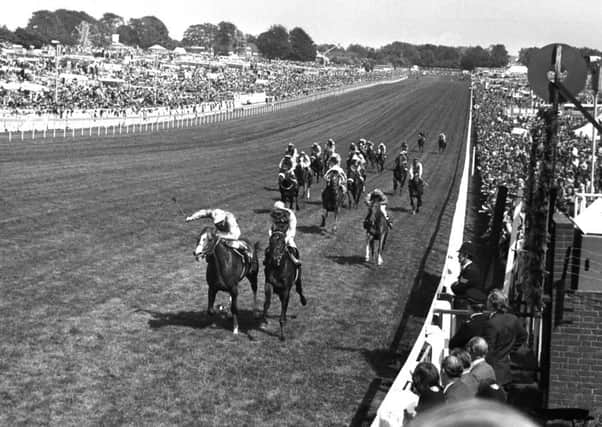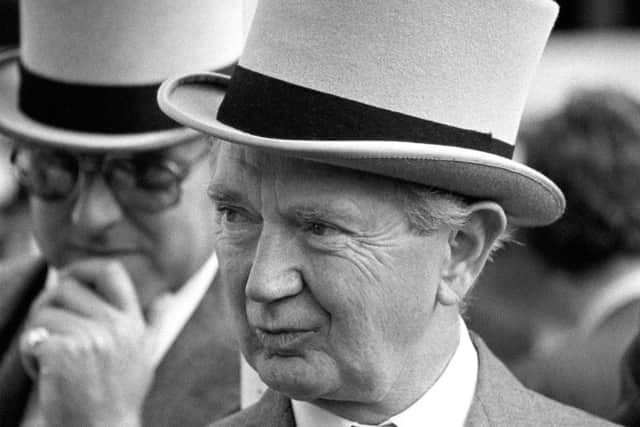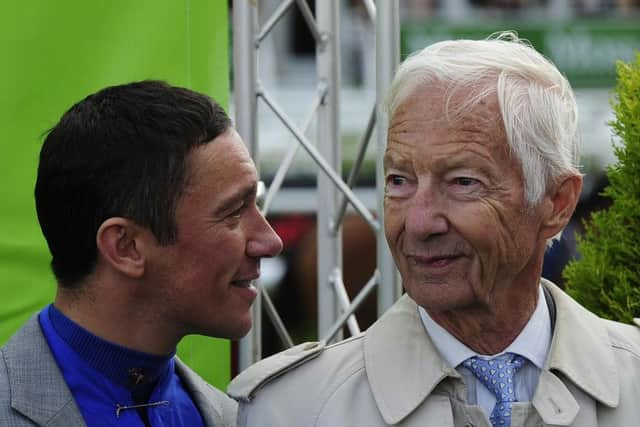Bygones: '˜No horse that I ever rode showed more courage than The Minstrel' - Lester Piggott and the Epsom Derby 40 years on


As the 22 runners gallop towards a mass of humanity, they are hit by a wall of noise cascading down from the double-decker buses lining the course as the Queen’s Silver Jubilee celebrations added patriotic fervour to the occasion.
On the right, Willie Carson and the unlikely Hot Grove on the cusp of victory; on the left, the white-faced The Minstrel straining every sinew under Lester Piggott, who already had seven Derbies to his name. In the shadow of the winning post, they are neck and neck.
Advertisement
Hide AdAdvertisement
Hide AdIt is that close. Immortality beckons for the victor; anonymity for the loser.


Forty years ago, this was a Derby for the ages – Piggott and Carson, at the peak of their powers, fighting the finish of their lives on a sun-kissed Wednesday when Londoners gave themselves the afternoon off to descend upon Tattenham Hill to add to the mystique of a Classic inaugurated in 1780.
Unlike the build-up to previous Derbies which were dominated by the annual guessing game over the legendary Piggott’s mount, there was no uncertainty.
He had told trainer Vincent O’Brien, and owner Robert Sangster, after disappointing defeats in the English and Irish 2000 Guineas that he would ride chestnut-coloured The Minstrel, whose four white ‘socks’ were considered to be unlucky.
Advertisement
Hide AdAdvertisement
Hide AdPiggott, a still sprightly 81 years of age, recalls the conversation well. “I said: ‘If you run him, I’ll ride him’,” he told The Yorkshire Post. “I added: ‘On decent ground, he will win’.”


For the so-called ‘housewives’ favourite’ assured of the support of once-a-year punters, Derby day was routine. “Just another race,” he said.
For his daughter Maureen, who is married to Skipton-born trainer William Haggas, it was a school day and she had become accustomed to the weight of expectation being the norm. There was no fuss at home, she said.
For the aforementioned Carson, whose mount Hot Grove had come to prominence when winning the Chester Vase by five lengths under Piggott, it was a day when he hoped to emerge from the shadow of his rival who was universally known as ‘the longfellow’ because he was unnaturally tall for a Flat rider.
Advertisement
Hide AdAdvertisement
Hide Ad“That was the year when I was riding a glorified hurdler and Piggott was on a champion,” Carson told me as he recalled a race like no other.


Even though The Minstrel, sired by the legendary Northern Dancer, was Piggott’s mount, the colt was small in stature and the hot favourite was, in fact, French challenger Blushing Groom, ridden by Henri Samani.
The great imponderable was whether this champion two-year-old would see out the mile-and-a-half trip – a question that applied in equal measure to The Minstrel, who would also be galloping into the unknown after negotiating the downhill descent around Tattenham Corner, racing’s very own roller-coaster.
Nothing was left to chance. The genius O’Brien, worried about his horse’s temperament, stuffed cotton wool in The Minstrel’s ears before the preliminaries and charged his young assistant John Gosden – now a Derby-winning trainer – with accompanying the colt as the field was led through the gypsy fortune-tellers to the start.
Advertisement
Hide AdAdvertisement
Hide Ad“The Minstrel did not turn a hair,” recalled Piggott who, in a rare admission, feared the worst when his horse broke slowly from the starting stalls. “I wanted to be handier,” said the master of Epsom.


Though the large field meant the runners would need luck on their side to get a clear passage, Carson, 74, was only worried about two horses – Blushing Groom and The Minstrel.
Acutely aware of their suspect stamina, he was just behind the pace-setting Milliondollarman as the cavalry charge rounded Tattenham Corner for the four-furlong sprint to the line – and racing immortality.
“I discussed tactics with the trainer, Fulke Johnson Houghton, and we decided to go for home further our than normal so we could test the others,” said Carson.
Advertisement
Hide AdAdvertisement
Hide AdRunning on resolutely, Hot Grove appeared – fleetingly – to have an insurmountable advantage as The Minstrel and Blushing Groom finally emerged from the pack.
Yet, as the favourite’s challenge faltered with two furlongs to go, Piggott asked for everything from his horse with a forcefulness that left his great friend and mentor Sir Peter O’Sullevan, the late broadcaster, uneasy.
Today, the rat-a-tat-tat ride would almost certainly have merited a lengthy suspension. Back then, he was riding within the rules – and The Minstrel was responding as Hot Grove’s lead diminished with every stride.
“Now was no time to be easy on him,” said Piggott. “Ears flat back – a sign that he was giving his maximum – he stretched out his neck, stuck out his head and galloped his heart out.”
Advertisement
Hide AdAdvertisement
Hide AdBy now, Carson’s only hope was that the line would come in time. Asked what it was like when Piggott loomed upside in any race, never mind the Derby, his answer was matter-of-fact: “Don’t remind me. Not a great feeling.”
Yet this wasn’t just sport. It was business. “It must have looked as if Willie would hold on, but I asked The Minstrel for a little more and from somewhere he found it to win by a neck,” said Piggott.
“No horse I ever rode showed more courage in a finish than The Minstrel that day.”
For Carson, there were no hard feelings. “That’s racing,” he said phlegmatically. His time would come. Two years later, the freewheeling Troy provided him with the first of four Derbies.
Advertisement
Hide AdAdvertisement
Hide AdFor Piggott, he was lucky to escape serious injury in the Epsom Oaks on the following Saturday when he parted company with Durtal on the way to the start and he was dragged along the turf. He would win a ninth Derby in 1983 courtesy of Teenoso, a record that is never likely to be broken.
For The Minstrel, he subsequently won the Irish Derby and Ascot’s King George VI and Queen Elizabeth Stakes before being sold for $9m to stand stud in America, the proceeds used by Sangster to set up the Coolmore breeding operation in Ireland which remains so dominant.
“To win those three races, he was one of the greats,” said Piggott.
“He needed good ground, but there were so many runners – like there will be this year.
Advertisement
Hide AdAdvertisement
Hide Ad“When we turned into the straight, I thought we’d left it too late.
“He was a fabulous horse. Genuine, tough, courageous. Of all my nine Derby runners, he had the best physique for Epsom – compact and exceptionally well balanced.
“I wish there’d been a few more like him.”
Why every Derby winner is a true champion – Piggott
HOW does Lester Piggott rate his nine Epsom Derby winners from Never Say Die (1954) to Teenoso (1983)?
In his beautifully illustrated book ‘Lester’s Derbys’, he ventured: “A distinction has to be made between the overall brilliance of the horse through his career, or in another race, and how that horse was on Derby Day.
Advertisement
Hide AdAdvertisement
Hide Ad“For me, Nijinsky felt at his peak when winning the King George at Ascot, and that day gave me the best feel of any middle-distance horse I ever rode. But in the Derby itself the performance of Sir Ivor was more exhilarating than Nijinsky’s. So I have to rank him my best Derby winner, with Nijinksy second.
“Third place would go to Crepello, a brilliant horse in the 2000 Guineas and the Derby, but sadly denied the opportunity ever to race against older horses.
“The Minstrel had the perfect Derby physique, and I never rode a horse in the race with a more courageous attitude. Roberto was very good when conditions suited. Teenoso and St Paddy both slaughtered the opposition. Never Say Die is so long ago that it’s hard for me to recall just how good he was. I suppose Empery has to be judged the worst of the nine. On the day each of them felt like a true champion. The Derby winner always does.”